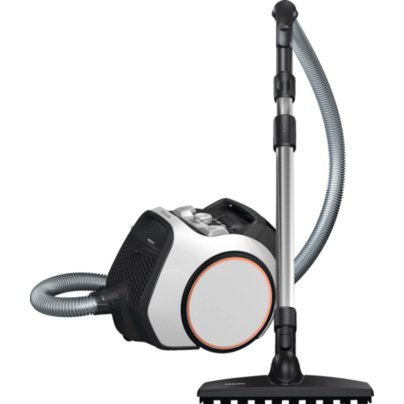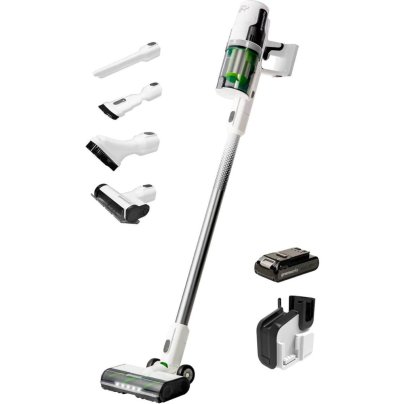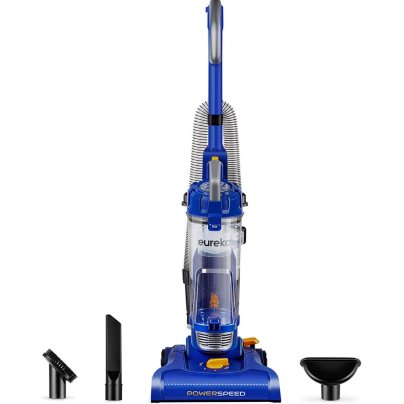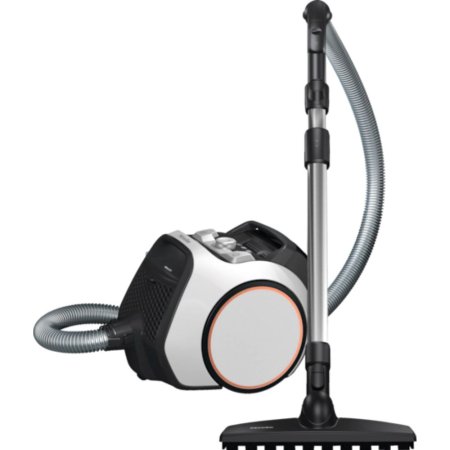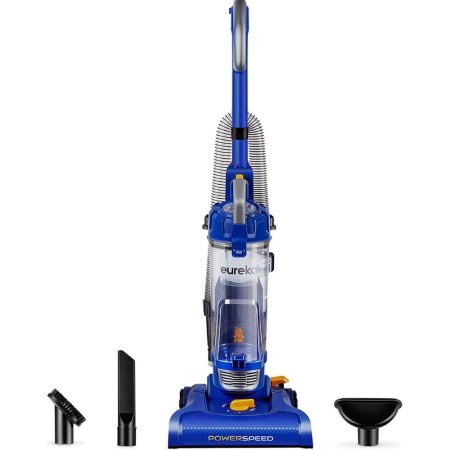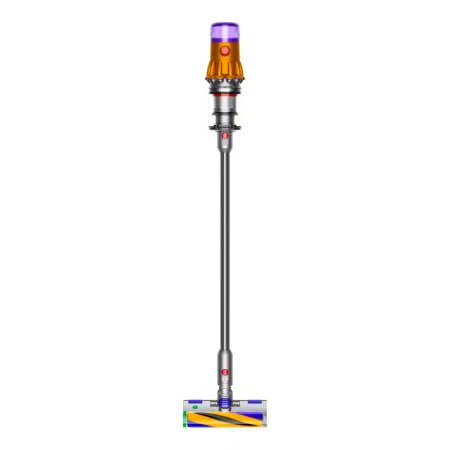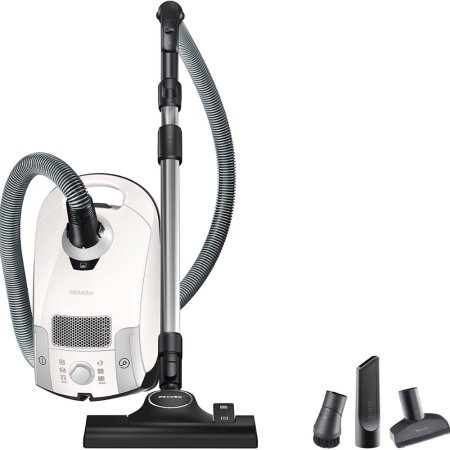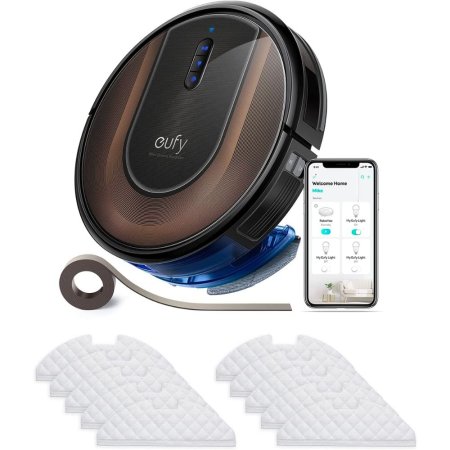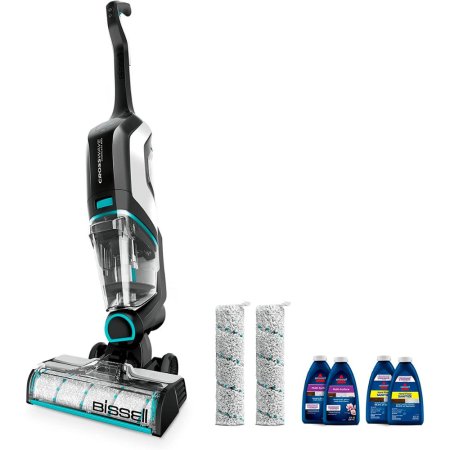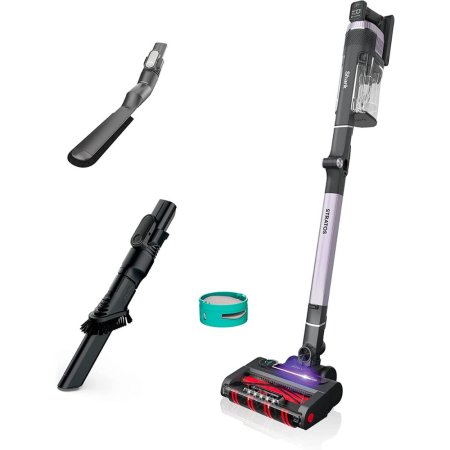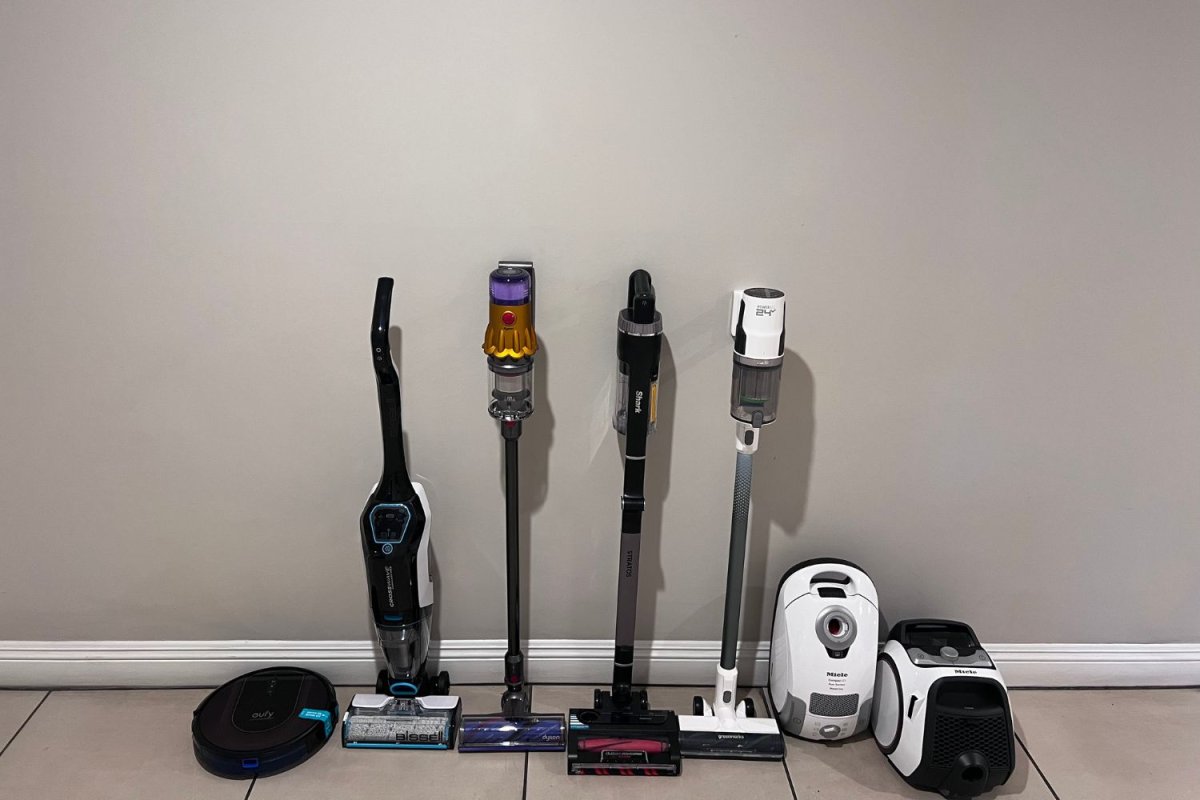
We may earn revenue from the products available on this page and participate in affiliate programs. Learn More ›
Tile floors are low maintenance, durable, and customizable. However, they can easily show dust and dirt, so finding the best vacuum for tile floors is a vital step in long-term tile floor maintenance. We tested several types of vacuums from cordless to canister and upright to wet/dry. The right one for you will depend on your home’s flooring types, how much of the flooring is tile, and the amount and type of daily foot traffic. A household that includes pets and children, for example, has more messes than a house of only adults.
This shopping guide includes recommendations for some of the best vacuums for tile floors along with information on how to narrow down the options, with expert advice from flooring specialists and professional cleaners. Our list of vacuums includes solutions for a variety of cleaning needs. Ahead, see how each one of these top models fared in our hands-on testing.
- BEST OVERALL: Miele Boost CX1 Parquet Bagless Canister Vacuum
- RUNNER-UP: Greenworks 24V Cordless Stick Vacuum
- BEST BANG FOR THE BUCK: Eureka NEU182A PowerSpeed Bagless Upright Vacuum
- UPGRADE PICK: Dyson V12 Detect Slim Cordless Vacuum
- BEST CANISTER: Miele Compact C1 Pure Suction PowerLine
- BEST ROBOTIC: Eufy RoboVac G30 Hybrid
- BEST WET/DRY: Bissell CrossWave Cordless Multisurface Wet/Dry Vac
- BEST STICK: Shark Stratos Cordless Vacuum with Clean Sense IQ

How We Tested the Best Vacuums for Tile Floors
Before choosing our lineup of products to test, we talked to a few experts to get their insights on specific aspects to focus on for best results. In our interview with Sean O’Rourke, a director for Floor Coverings International, a nationwide flooring company with extensive tile experience. O’Rourke’s key advice is to make sure shoppers have the correct vacuum attachments when cleaning certain tile surfaces. “A roller bar that hasn’t been cleaned regularly may act as an abrasive and would not be suitable for a smooth or glossy tile floor like marble.” He also suggests avoiding heavy units where the wheels can cause “vibration that may eventually loosen grout joints”
With this in mind, we got our hands on our top picks and performed a variety of tests to see how well these models cleaned tile floors. While the floor already had a fair amount of pet hair on it thanks to our English bulldog and chihuahua mix volunteers, we also tested with dry oatmeal because it has small, finely ground particles. Additionally, we tested how well the vacuum picked up larger pieces, such as dog kibble.
We noted not just how easily each model picked up dirt and debris but how easy it was to maneuver. In addition to tile, we also vacuumed laminate flooring and carpet as well as an area rug. Then we tested each accessory before emptying the dustbin to see how easy it was to clean.
Finally, our research would not be complete without taking advice from professional cleaners, so we talked to Diana Cierchorska, the general manager of Park Slope Cleaning in Brooklyn, New York. “Vacuuming is just part of the game for tiles; you might need to mop now and then.
Watch out for those wheels–rubber or felt ones are your buddies to avoid scratches.” Taking this on board, we made sure that most of our top recommendations have suitable wheels to avoid scratching hard floor surfaces, and even included our favorite wet/dry combo to vacuum and mop simultaneously, a top feature for shoppers looking to clean their homes more efficiently.
Our Top Picks
The following vacuums, all of which we tested, offer features tailored to tile floors. Canister vacuums with powerful automatic suction adjustment, cordless models, and wet/dry vacs that pull double duty made the list. Each one of these models can suit a variety of cleaning needs and homes.
Best Overall
Miele Boost CX1 Parquet Bagless Canister Vacuum
Pros
- Retractable 21-foot cord allows for extensive cleaning across rooms
- Dirt cup lifts up easily, making cleanup a snap
- Powerful suction easily picks up large and small debris
Cons
- A bit pricey compared to similar options
- Hard to see if the dirt cup is full
Product Specs
- Type: Canister
- Cordless: No
- Weight: 16 pounds
Miele is a premium brand known for its excellent vacuums, and we found the Boost CX1 Parquet Bagless Canister Vacuum did not disappoint. With an upholstery nozzle, crevice nozzle, and dusting brush with synthetic bristles, it’s great for all surfaces from tile to hardwoods, area rugs, and carpeting.
While it is compact for a canister vacuum, it still packs a punch. With an airflow of 100 km per hour, this vacuum is powerful. In testing, it easily picked up all types of debris, from oatmeal to pet hair to dog kibble, making it a great choice for homes with pets and kids. This vacuum also sucked up everything the first time, so it’s an ideal option for anyone who wants to clean things fast.
Not only is this vacuum a powerful cleaner, but it’s also well designed. With wheels on the outside of the canister and casters on the inside, this vacuum was easy and comfortable to maneuver. This clever wheel configuration also prevented the vacuum from tipping over or hitting furniture.
When we finished vacuuming, we were easily able to pull the dirt cup from the canister and empty it in seconds. Plus, we just had to press a button to retract the cord—no winding necessary—and put it away. Besides the hefty price tag, the only downside we noticed was that the dark plastic color of the dirt cup made it hard to tell if it was full.
Get the Miele Boost CX1 vacuum at Miele.
Runner-Up
Greenworks 24V Cordless Stick Vacuum
Pros
- Digital screen makes it easy to increase and decrease power
- Extremely easy to maneuver around and under furniture
- HEPA filter is washable and reusable
Cons
- Battery only works for 10 minutes on high-power mode
- Hair gets stuck in the filter; requires frequent maintenance
Product Specs
- Type: Stick
- Cordless: Yes
- Weight: 5.1 pounds (without the battery)
The Greenworks 24V Cordless Stick Vacuum is our runner-up choice because it’s a great all-purpose appliance that is useful for cleaning up everyday messes and works as a handheld. Loaded with accessories, it includes a deep-cleaning motorized brush, 2-in-1 round brush, soft bristle brush, and crevice tool. All of these extras make it great for tile as well as other surfaces like hardwood, carpet, and area rugs.
It also has a light to illuminate small particles of debris on the floor including pet hair, as well as specs of dirt and dust, making it easier to get our home extra clean. While the light was helpful, we felt it could have been a little bit brighter. Still, it was useful for illuminating some of the pet hair on the floor we would not have otherwise seen. Finally, and perhaps best of all for those who like to keep their home clutter-free, this vacuum has a removable battery, so users can put away the vacuum even while the battery charges.
Get the Greenworks vacuum at Amazon or Greenworks.
Best Bang for the Buck
Eureka NEU182A PowerSpeed Bagless Upright Vacuum
Pros
- Light weight allows users to clean for longer periods
- Multiple setting options
- Comes with several accessories
Cons
- User must bend down to adjust the settings for different surfaces
- Plastic was thin, making it feel cheaper and less durable
Product Specs
- Form: Upright
- Cordless: No
- Weight: 10 pounds
Finding a vacuum cleaner under $100 that works like a far more expensive model isn’t easy, but the Eureka NEU182A PowerSpeed Bagless Upright seems to check every box. It also has plenty of features more common on far pricier models, including a dynamic motor designed to lift heavy debris, a brush roll, a 12.6-inch-wide cleaning path, a 25-foot cord, and a 7-foot-long hose. Better yet, at just 10 pounds, it was easy to maneuver from room to room and around furniture.
We felt the suction on this vacuum was quite impressive, especially for the price. It even sucked up dirt from our thick grout lines. Measuring up to more expensive models, it works well on all surfaces including tile, hardwood, carpet, and area rugs. It’s a great choice for the whole home.
On the downside, we noticed that the plastic on this model was thin, making it seem less durable. We also didn’t like that we had to bend down to adjust the settings for different surfaces. However, for such a great price, this model still had great suction and a range of features and accessories.
Get the Eureka vacuum at Amazon.
Upgrade Pick
Dyson V12 Detect Slim Cordless Vacuum
Pros
- The digital screen has multiple language options
- Extremely lightweight; greta for prolonged use
- Light illuminates hidden dust particles for easier cleanup
Cons
- Small dustbin needs to be emptied more often
- Only 1 attachment, the laser slim fluffy cleaner head, has a laser
Product Specs
- Form: Stick
- Cordless: Yes
- Weight: 5.2 pounds
Small but mighty, the Dyson V12 Detect Slim Cordless Vacuum did not disappoint, scoring perfectly in nearly every testing category. While it’s an excellent vacuum for all surfaces, the laser on the hard floor attachment makes it a particularly great choice for tile flooring; it illuminated tiny pieces of dirt, even revealing microscopic dust along grout lines and in crevices.
It comes with just about every accessory one would ever need, including a laser slim fluffy cleaner head, a motorbar cleaner head, a hair screw tool, a crevice tool, a combination tool, and a wand clip. There’s almost nothing this stick model can’t clean.
This vacuum is ideal for people who live in small spaces because it’s so narrow and easy to store. Install the docking station on the wall of a closet or pantry and this model will hardly take up any room.
We also loved that it turns on and off with a button, unlike other Dyson models that require the user to hold down a trigger. Your hands will thank you.
The only improvement we would make to this model is a slightly larger dustbin. So for users who have pets or live in large homes, it might be best to go with a different choice.
Get the Dyson vacuum at The Home Depot, Target, Best Buy, or Dyson.
Best Canister
Miele Compact C1 Pure Suction PowerLine
Pros
- Retractable cord for quick and easy storage
- Available in multiple colors to suit individual tastes
- Can use a foot to turn it on and off
Cons
- Assembly and accessory attachment is not intuitive
Product Specs
- Form: Canister
- Cordless: No
- Weight: 14 pounds
With a dirt cup capacity of 3.5 quarts, this model is smaller than Miele’s full-size canister vacuums but doesn’t lack suction power. A combination of the 1,200-watt vortex motor and vacuum head design creates uninterrupted suction that pulls in more dirt and dust while enhancing energy efficiency. It features an 18-foot cord and weighs less than 15 pounds.
This model includes six suction powers that are adjustable by a dial on the canister body. Despite its compact size, it holds three accessories—a crevice tool, a dusting brush, and an upholstery tool—directly on the hose. It also has a HEPA filter to remove common allergens. Like other Miele vacuums, this model comes in at the high end of the price range. However, this compact model is one of the company’s more affordable options.
In testing, we really liked using this vacuum because it felt practically weightless, thanks to its lightweight hose and head. Although it is smaller than other Miele models, we found that it still had strong suction picking up small debris like oatmeal and large debris like kibble off of all our tile floors. We also appreciated that the pole extended up to the ceiling, making it great for sucking up spider webs, dust, and other hard-to-reach debris. Considering how many accessories it comes with, we think that this vacuum would be an ideal choice for just about any home.
Our only complaint about this vacuum is that unlike most vacuums available today, the assembly wasn’t intuitive and we had to consult the manual multiple times. It also took a few tries to get the hang of attaching the accessories.
Get the Miele Compact C1 vacuum at Amazon or Miele.
Best Robotic
Eufy RoboVac G30 Hybrid
Pros
- Easy-to-use app isn’t buggy and makes it easy to control the robot
- Dual gyroscopes pick up twice the dust, hair, and debris
- Impressive suction picks up a variety of debris
- Slim body helps it easily clean under furniture
Cons
- Can’t replace a conventional vacuum because the motor isn’t as strong
- Robot can’t fit into every corner
Product Specs
- Type: Robot
- Cordless: Yes
- Weight: 5.91 pounds
The Eufy RoboVac G30 Hybrid is a great robot vacuum that has both mopping and vacuuming capabilities, making it ideal for tile floors and other surfaces. It has many useful features including drop-proof technology (useful for homes with stairs), an anti-collision sensor to protect furniture, and a hassle-free filter that’s easy to clean. In testing, it worked impressively, picking up both small and large scraps of food as well as dust and pet hair with ease.
This model also navigates incredibly well, managing feats we haven’t seen with other robot vacuums. It managed to get itself out of the space between chair legs and even on and off a sheepskin rug without difficulty. It seamlessly transitioned between different floor types.
We also found that the G30 Hybrid mops well for a robot and can use either disposable or reusable cloths. Still, it won’t mop up stuck-on debris or replace a regular manual mop.
Another thing that we really liked about this model is that it includes boundary strips. Easy to use, they assure users that the robot vacuum will avoid the baby’s room, the dog’s water bowl, or any other area that it shouldn’t go near.
Get the Eufy vacuum at The Home Depot.
Best Wet/Dry
Bissell CrossWave Cordless Multisurface Wet/Dry Vac
Pros
- Tank has indicator-level marks for room sizes to optimize water and solution use
- Area rug setting makes it easy to clean area rugs without damaging them
- Maneuverable head and body make it easy to clean an entire room quickly
Cons
- Doesn’t have the strongest suction
Product Specs
- Type: Upright
- Cordless: Yes
- Weight: 11.5 pounds
Able to vacuum and mop simultaneously, the Bissell CrossWave Cordless Max is a great multitasking appliance. Though it’s designed to be used with Bissell’s floor-sanitizing solutions, it can also be used with other floor-cleaning products. Better yet, it’s cordless, so users don’t need to bend down while cleaning. This is also a particularly good choice for homes with area rugs because users can switch modes with just the push of a button. It also runs for a generous 30 minutes.
This easy-to-maintain model has a self-cleaning mode and also connects to the Bissell app through Wi-Fi so users can get alerts, track maintenance, and receive tips on how to maximize the use of the product.
Our tests revealed this product is in fact a good multitasker, so It’s a great product for anyone who wants to save time. The microfiber roll spins quickly, and we were impressed at how well it removed stuck-on dirt. While it proved to be adequate for vacuuming up light debris like pet hair, we had to go back over larger piles of food scraps like oatmeal and kibble. Those with busy households may need a traditional vacuum in addition to this one.
Get the Bissell vacuum at Amazon, Wayfair, Target, or Bissell.
Best Stick
Shark Stratos Cordless Vacuum with Clean Sense IQ
Pros
- Easy to maneuver around corners and under furniture
- Lightweight; ideal for daily use without tiring out
- Folds over for easy storage
Cons
- Highest setting drains the battery fast
- Could use more accessories
Product Specs
- Form: Stick
- Cordless: Yes
- Weight: 8.9 pounds
For shoppers who are looking for a great stick vacuum and don’t quite have the budget for a Dyson, the Shark Stratos Cordless with Clean Sense IQ is a great option. We found it picked up crumbs, small bits of food, pet hair, and dust from those pesky tile grout lines. With three levels of power, it was easy to tailor the vacuum to all kinds of messes. We also liked the odor-neutralizer technology, especially because the test home has two pets.
This stick is also a particularly smart choice for allergy sufferers because it has not only a washable HEPA filter but also foam and felt filters. While it doesn’t come with a ton of accessories, the anti-allergen dusting brush and crevice tools are certainly adequate for getting the job done in most homes.
The only thing we didn’t like about this vacuum is that the highest setting drained the battery too fast. We also wished it had as many accessories as the Dyson, but at a lower price point, it still exceeded our expectations.
Get the Shark vacuum at Amazon, Target, or Shark.
Jump to Our Top Picks
What to Consider When Choosing a Vacuum for Tile Floors
Every home is different; likewise, users have different preferences when it comes to vacuum cleaners. Some may prefer the convenience of a cordless model, while others like the power of a canister vacuum. In addition to these personal preferences, those on the hunt for a new vacuum will want to keep these important considerations in mind while shopping.
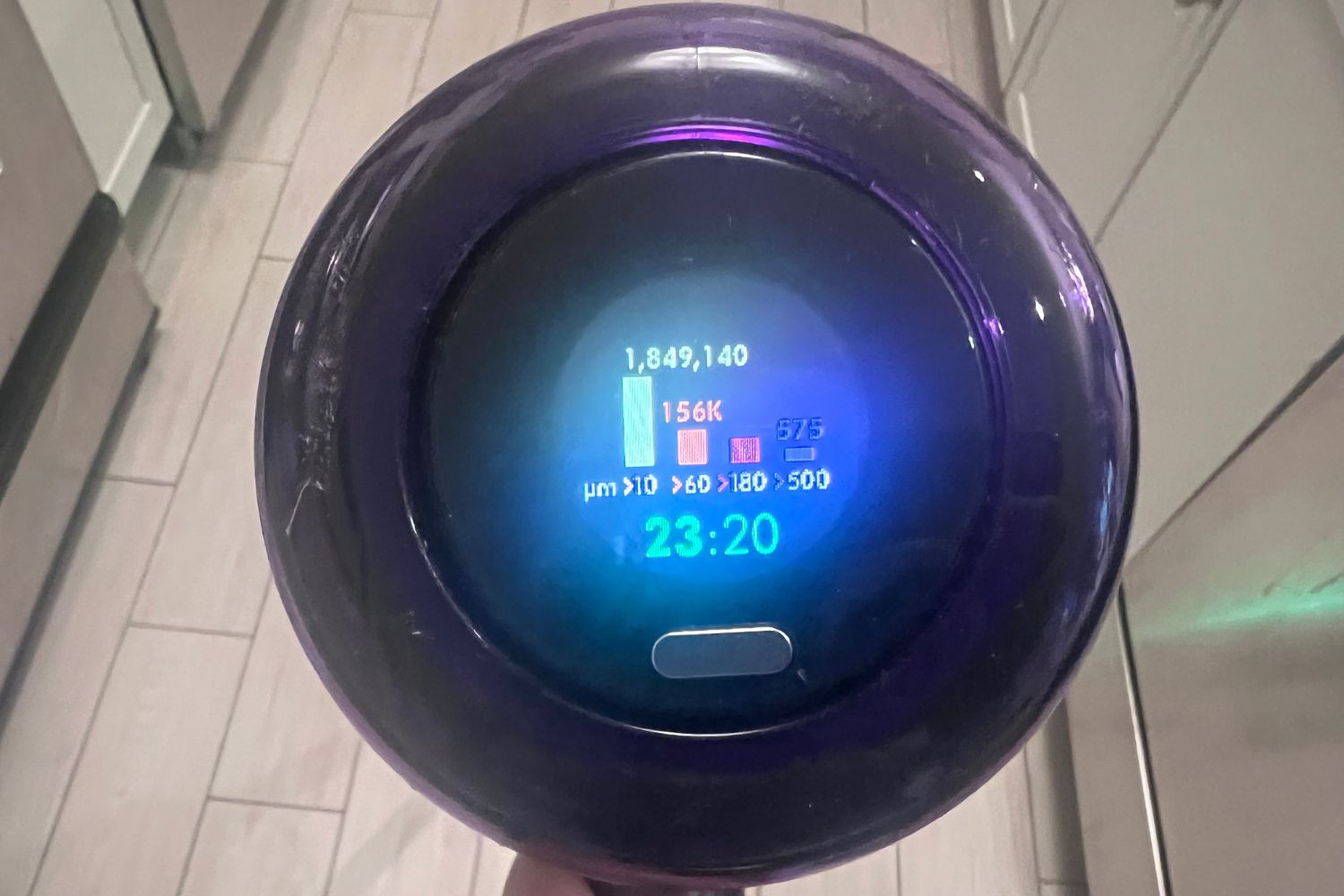
Home Size
A home’s size acts as a starting point for choosing vacuum size and power—the larger the house, the larger the vacuum. A stick or cordless vacuum may be enough to clean a small home or apartment. However, it could run out of battery power cleaning a space larger than 1,000 square feet.
The vacuum size also determines how often a user has to empty it. A small stick vacuum could fill up every time it’s used in a spacious home, whereas a large, bagged upright may only fill every few weeks. It’s a balancing act between the vacuum size and power along with the available storage space in the home.
It comes down to this—the vacuum size and power should complement the home size.
Corded vs. Cordless
Corded vs. cordless—the ongoing debate about which is better isn’t likely to end soon. The choice comes down to individual preferences and the intended use of the vacuum. Each kind has its benefits and drawbacks.
Corded vacuums never run out of power, providing full suction no matter how long the vacuum is used. However, the cord’s length does affect how the user cleans. A cord only stretches so far before the user has to stop and switch outlets. Plus, the user has to either move the cord or maneuver around it—an extra step some people dislike.
Larger vacuums, like full-size uprights and canister vacuums, have the longest cords, with some reaching nearly 30 feet. Stick vacuums have shorter cords in the range of 15 to 20 feet. Most corded models have an onboard cord storage system built into the vacuum’s body, requiring users to wrap the cord for storage and adding another extra step in the cleaning process. On the other hand, retractable cords can be found on some models, making storage quick and easy.
While they tend to be less powerful than their corded counterparts, cordless vacuums offer conveniences that corded vacuums can’t. Most notably, users can carry them almost anywhere in their homes without having to worry about tripping over a cord or unplugging and replugging it elsewhere. They also tend to be rather lightweight. In the past, cordless vacuums could be heavy due to the weight of their lead-acid batteries. However, most modern models now have relatively lightweight lithium-ion or lithium-ion polymer batteries.
These two types of batteries don’t have issues with the memory effect, in which a battery loses its ability to hold a full charge if it’s not completely discharged with each use. They’re also more eco-friendly than past lead-acid, nickel-cadmium, or nickel-metal hydride batteries, which are more common on older cordless vacuums.
Motor
Vacuum cleaners have a universal motor that operates on both direct current and alternating currents. In general, a good indication of motor power is amps. Vacuums with higher amps have more power and, consequently, more suction power, though it’s worth noting that a vacuum’s total amps include power used in other parts of the vacuum as well.
In addition, keep in mind that high suction power uses more electricity. A small home or apartment may not require a high-power vacuum, whereas a larger house would benefit from a vacuum with stronger suction power.
Airflow and Filtration
Vacuum airflow is often measured in cubic feet per minute (cfm), with the best vacuums having an airflow of more than 125 cfm. However, airflow should be balanced with the vacuum’s suction, also called the water lift or static pressure. A vacuum can have good airflow but low suction. Good suction power—measured in inches of water lift, or how many inches the motor will lift 1 inch of water vertically—starts at 80 inches. Balanced vacuum specs should have more than 125 cfm and more than 80 inches of suction power.
All that airflow also needs good filtration. High-efficiency air particulate (HEPA) filters remove particles as small as .3 microns. Allergy sufferers benefit from this filtration level, which removes pet dander, dust mites, pollen, and other common allergens.
Maneuverability
Lugging around a clunky vacuum adds extra work to cleaning. That’s where maneuverability comes into play. Stick and cordless vacuums offer the best maneuverability, especially if they have a swivel head that pivots around furniture and everyday household obstacles.
As far as full-size models go, uprights have a leg up on canister vacuums, which can be cumbersome to drag. However, canisters tend to perform better on tile floors due to the vacuum head design. These designs make them one of the best vacuums for tile floors.
Noise Level
The average vacuum cleaner produces 75 decibels (dB) of noise. To give an idea of how loud that is, the average home’s noise levels stay around 40 dB. Vacuums that run at 71 to 75 dB will sound fairly loud. A quiet vacuum runs between 65 to 70 dB.
Bag/Canister/Dustbin Capacity
Vacuum capacities vary widely, from robot vacuums and stick models accommodating around .5 liters to full-size uprights and canister models that can hold around 4.5 liters. More considerable volumes allow users to empty the bag, dustbin, or canister less often. As mentioned above, vacuum capacity should fit the home size. Homes that are larger than 1,000 square feet may necessitate the user emptying a small bin in the middle of vacuuming. Vacuums with small bins work best for small-spill cleanup or homes less than 1,000 square feet.
Accessories
Accessories expand a vacuum’s usefulness. Standard accessories typically include a crevice tool, upholstery brush, and extension wands. However, a few other extras worth considering are additional hoses (for canister vacuums), motorized brush heads, and pet brush heads.
Onboard storage keeps accessories at the user’s fingertips. However, it also adds weight. Other designs have a storage bag or a case for extra accessories, which keeps the vacuum’s weight to a minimum. A downside to this is that a separate bag or a case can also be misplaced.
A more recent addition to vacuum models is a light to help spot hairs, dust and debris that may otherwise go unnoticed. This was a highlighted point in our interview with Aaron Christensen, vice president of nationwide professional cleaning service Homeaglow. “A light to illuminate what you’re actually working with can turn a time-consuming, full-surface-area clean into an efficient spot clean.”
FAQs
Thankfully, vacuums that work for tile floors often work well on other types of flooring, too. Some models have automatic sensors that change the vacuum height or suction based on the flooring type. This feature allows users to seamlessly move from tile to carpet and back again. We’ve provided a few more tidbits and tips for vacuuming those tile floors.
Q. Are cordless vacuums suitable for tile floors?
Today’s cordless vacuums generally have good suction that works well on small areas (less than 1,000 square feet) of tile flooring. They’re great for spot cleaning in large homes, but the battery life could limit their use as a whole-house vacuum in homes that are larger than 1,000 square feet. However, for a tiny space or a home with a small tile area, a cordless vacuum provides maneuverability and portability to accommodate these areas of the home.
Q. Do robot vacuums work on tile floors?
Many robot vacuums work well on tile floors. Those with multiple suction settings and automatic sensors that adjust the suction setting based on the flooring type perform the best. Models with numerous suction settings let you adjust the suction based on the amount of debris in the home. For example, pet hair typically requires extra suction, so a model with a suction boost setting or mode would probably work best.
Q. How do you vacuum a tile floor?
Make sure the floor is clear of larger objects that could get sucked into the vacuum. If the vacuum head height is adjustable, lower it to the bare floor setting or the lowest setting available. Finally, follow a vacuuming pattern to keep track of where you’ve vacuumed.
Meet the Tester
Amanda Lauren is an interior design, lifestyle, and cleaning expert who has written for many publications including Forbes, Real Simple, and Better Homes and Gardens. She has tested a variety of products for Bob Vila including vacuums, mops, shower squeegees, and more. She prefers to clean with vinegar and water whenever possible, and pet stains are the bane of her existence.
Additional research provided by Stacey L. Nash.
